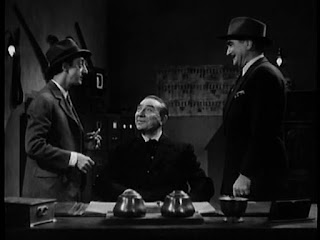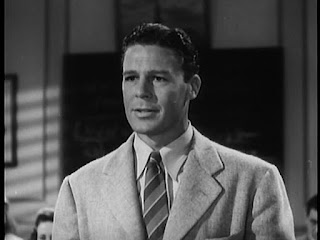Before watching the next three films -- all of which, as it happens, revolve around criminal schemes that run afoul of the law -- be warned: each harbors a serious issue that, in the case of one of these films, can damage your television or even your health. (No, we're not kidding.)
Bowery at Midnight (1942)
Grade: C+
To see Béla Lugosi onscreen in a starring role is, alas, to know you've already spotted the villain. But for the first few minutes of Bowery at Midnight, Béla puts up a good front as Karl Wagner, the kindly operator of a soup kitchen/flophouse. Wagner doesn't ask a lot of questions, or try to save anyone's soul...
...because his is already long gone. Wagner leads a double life, you see, as the mastermind behind a series of particularly brutal robberies -- and his associates have a nasty habit of ending up dead.
And that goes double if they get the bright idea of talking smack about him while he watches on his secret TV (which, to our great pleasure, Bowery at Midnight makes no attempt whatsoever to explain).
Did we say Wagner leads a double life? Well, it's really more of a triple life --
-- for, by day, he's Professor Brenner, noted criminologist and devoted husband. While his criminal associates know that Wagner has a dark side, no one knows that Brenner is Wagner -- and he means to keep it that way.
Wagner/Brenner makes for a refreshingly evil character, and a part tailor-made for Lugosi. He has no compunction about killing anyone, and we mean anyone, who gets in his way. The movie's body count is impressively high, and as another site notes, it quickly establishes that any character can die at any time -- something that puts us in a completely different headspace, so to speak, from the usual "everything's OK in the end and only the bad guys get it" fare.
Of course there has to be an infusion of spunk somewhere along the line, right? And Bowery is no exception, though it distributes its moxie more or less evenly between Wagner's assistant Judy (Wanda McKay), a nurse who knows nothing of her boss's dark side --
-- and her wealthy boyfriend Richard (John Archer), who -- quelle coincidence! -- is taking Brenner's criminology class. Annoyed and offended by Judy's long nights in the Bowery, Richard decides to scope things out for himself. This is not one of his better ideas.
Bowery suffers from a mild case of One Subplot Too Many, though other writers have overlooked one possible motivation for its bizarrely tacked-on zombie theme. Let's put it this way: if zombification is fully reversible, you can off as many people as you want without violating the Hays code.
Now, a very important warning: at approximately 55:41 into Mill Creek's print of Bowery at Midnight, the viewer is hit out of nowhere with an ear-splittingly loud noise (probably feedback of some kind) in one channel.
It's far louder than the surrounding audio, sounds like a cross between a siren and a Slinky from hell, and is more than capable of blowing out your speaker if you've got the volume turned up (and who doesn't when trying to make out the dialogue on these Mill Creek DVDs?). If you're listening on headphones, it could certainly cause hearing damage.
It also made us jump about 10 feet even though we had a vague idea it was coming (thanks to a warning on another site, and we're grateful for the solid), marking the first genuinely scary moment we've had on this box. And when we watched Bowery again for this review, K. spent the entire time cringing in apprehension.
So how will you know when it's coming, short of watching the counter on your DVD player? Well, watch out for this scene in which Judy is asking one of the flophouse residents to run an errand for her, and hands him some money:
Right after that, she leaves and walks into the next room, and that's when the noise happens. Turn down your volume in advance! You'll know you're clear when she begins to speak with this man, "Doc" Brooks:
If all this sounds overwrought, believe us, it's no joke. Consider yourself warned!
Midnight Shadow (1939)
Grade: F
Another Sack film with an all-black cast, Midnight Shadow poses the question: how do you stretch 25 minutes' worth of film into a 50+ minute featurette?
Why, with "comic relief", of course -- if you can use that term to describe the asinine and joyless antics of the two wannabe detectives who mug their way through this film. We remembered Midnight Shadow as one of the worst films we'd seen on this box, but for the first 15 minutes or so, we found ourselves questioning this assessment: did this silly but inoffensive murder-mystery really deserve that much opprobrium?
But once Buck Woods and Richard Bates show up onscreen, look out. It's not merely that they're unfunny, or that there's something embarrassing and painful about watching them carry on. They're just flat-out obnoxious, so insultingly stupid that it moves us to anger.
And it doesn't help that Richard Bates has a creepy, young-old face that makes his role as "Junior" somehow disturbing -- a bit like John Hurt's early scenes in Heaven's Gate, we suppose, but much, much worse. Ostensibly a young man, he certainly doesn't look much younger (if at all) than his onscreen parents.
So be warned: the presence of these two pretty much tanks any chance for Midnight Shadow to be what it could have been, i.e. a threadbare but mildly entertaining romp whose rough edges and incoherent script are almost forgivable in light of its brevity and circumstances.
Instead, it's just a big steaming pile of anhedonia. Sorry, Sack.
Torture Ship (1939)
Grade: C-
Let's get the warning out of the way upfront this time: Mill Creek's print of Torture Ship is missing the first 9-10 minutes of the film, give or take. And while you can infer the gist of the missing material pretty quickly -- these people are criminals on a boat, this person's a scientist conducting experiments on them, etc. -- it still has a major impact on the film's coherence and enjoyability.
It turns out that neither YouTube nor Archive.org can supply the missing beginning to the film, so we digitally "rented" a copy of Sinister Cinema's version, which seems to be the only place to get those opening minutes. The Sinister print is certainly better than Mill Creek's copy, but much as with The Ghost Walks several entries back, it also has some unexpected flaws. Among these are a scene that's been mysteriously replaced by an exact repetition of a later scene (which is confusing as hell), and a couple skips and audio dropouts that aren't present in the Mill Creek version.
If you choose to watch the Mill Creek version of Torture Ship (from which all of these screenshots are taken), you'll be a bit lost for a while, but you'll still be able to enjoy the film's wealth of interesting faces. And it sure has a lot of them, though there's a clear winner in the bespectacled fellow pictured at the very start of this review, Skelton Knaggs, a man who -- as you can see -- looks exactly like his name.
Our female protagonist, Joan, is played by Julie Bishop -- who, speaking of fah-chays, looks a bit like the young Arlene Francis (a cutie in her youth, if you didn't know that: certainly worth a Google, no need for a Bing).
An innocent secretary unwittingly mixed up in a murderous racket, her only lifeline is heroic Lt. Bob Bennett (the ever-redoubtable Lyle Talbot), nephew to the scientist we mentioned a while back. And boy, does she give him bedroom eyes when he saves her bacon.
And speaking of women of a certain age who work in quartets, the comic relief in Torture Ship is supplied by Ole Olson (Eddie Holden), a stereotyped Swede and spiritual grandfather of Sven Lindström. Cowardly but sweet-natured -- and full of gratuitous transformations of palato-alveolar affricates into palatal approximants, naturally -- he gets the film's best line, or at least its strangest:
"If a gun was even two feet in front of me, it would run like 'Hail, Columbia'."
In its Mill Creek-ified form, Torture Ship is a murky and unsatisfying affair; with the opening restored, it's a marginal but reasonably entertaining hour of plots and counterplots, with a little woo-woo science for added spice, and at least one unforgettable face.
If you're reading this and decide to assemble the best parts of the Mill Creek and Sinister prints into some sort of restoration project, drop us a line with the download link -- we'd love to see your new cut!

























No comments:
Post a Comment